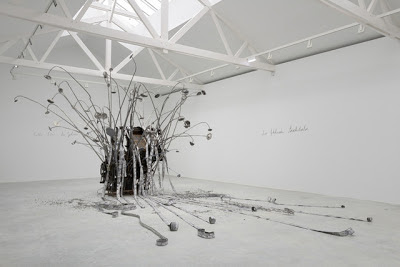 |
| Installation View, Thaddeas Ropac, Paris-Pantin |
 |
| Anselm Kiefer, Für Rabbi Löw, 2010-11 |
As further celebration, the new series of
Kiefer works — new in that they are brought together here for the first time,
but not necessarily created for the space — was profound and moving. The themes
and aesthetic concerns of Die Ungeborenen
are not new to Kiefer’s work, and those familiar with his oeuvre will know them
well from his previous series. We will remember the steps made of lead books
leading (or not) to the sky on a
canvas of ashen skies in the Heaven and
Earth series. And the tragic and poignant remnants of children’s
foreshortened lives have covered Kiefer’s canvases for decades. These, together
with the shattered glass and rusted metals so typical of Kiefer’s works have,
and continue to remind us of the weight of the Holocaust on contemporary
history. And for Paris people, the dead sunflowers that nevertheless reach toward re-birth are very familiar to us
from, Hortus Conclusus 2007 permanently installed in the
Louvre. What is rare and makes this exhibition welcome, is that in Paris it’s
rare to see such a series of this many monumental Kiefer works under one vast roof.
 |
| Anselm Kiefer, Hummelsschlucht, 2011-12 |
As an example of the expansive works on
display, Himmelsschlucht (2011-12) is
heartwrenching. A stack of child-sized rusted and battered bed frames with lead
pillows strewn on the springs is precariously placed on a cement “pedestal.”
The beds are on wheels just as they would be in a hospital, or if they were
there for the sick, and their placement one on top of another gives the idea
they are no longer needed, that their one-time occupants are long gone. A
notice, or label, in lead hangs from each frame, with chalk writing, awaiting
erasure and the bed’s next occupant. Wires, like the string that might hold
together a bundle of belongings on the back of a trolley, give the impression,
or perhaps articulation of the intention to hold the bed frames together. In
Kiefer’s works, childhood and sickness belong together, like life and death.
The contradiction is always alive on his monumental paintings, in his
sculptures.
 |
| Anselm Kiefer, from Die Ungeborenen, |
As always the works are as much about
medieval mysticism, German history, literature and legend, as they are about
Kiefer himself, and about the artistic process of an overbearingly male artist.
In one sculpture, strips of what look like paper printed film grow like the
ashen sunflowers out of an aging printing press and decaying typewriter. The
images depict the concrete and iron towers of Merkaba, the seven heavenly palaces that Kiefer erected on his
property in Barjac, the south of France. The “palaces” could be either in a
state of incompletion or destruction – typical of the ambiguity and
non-determinism of Kiefer’s work. But the point is, the repeated frames of his
own work, and the reuse of certain motifs and objects such as the rocks that
might weigh down the witches or imbalance the scales of justice, the space set
up between images and words, things and images, as expressive of his own
creative process, speak Kiefer’s self-obsession, his concern with his own
development. Indeed, the shards of lead strewn across the floor of the Paris-Pantin
gallery indicate the destruction that surrounds this creative process.
 |
| Anselm Kiefer, Die Ungeborenen (Niemandsrose), 2011 |
 |
| Anselm Kiefer, Die bösen Mütter, 2007 |
Everything in Kiefer’s world is grey,
though the works in Die Ungeborenen
introduce the copper green, the color of oxidization, of age, weathering,
exposure to the elements, all of which intensify an agitated, tactile surface. In
Die bösen Mütter, infinite lines of what
appear to be graves, or a dead landscape of dense un-navigable mud and
charcoaled wood gives substance to the doom of grey. And yet, there is always a
horizon line, and even when it shows that land meets an apocalyptic grey sky,
the line somehow holds the possibility of hope. On the horizon line of Die bösen Mütter is a trace, or perhaps a deliberate overpainting
of red, a red that up close is like breath, fire and energy in a dead world. And
the chairs, however long it is since they saw life, suspended in the grey sky, drift
up to heaven.
When I asked the people at Galerie Thaddeus
Ropac why the reproductions in the catalogue did not always correspond to the works on display, their answer was in keeping with the unpredictability of Kiefer’s
otherwise Romantic worlds. Apparently, Kiefer kept changing the exhibition
right up to the very last minute, changing his mind about what should be
displayed. I wouldn’t be surprised if when I go again, I might actually be
going to a different exhibition, retaining its perplexity and mercurial
dimensions even in the context of display.
All Image courtesy Galerie Thaddeus Ropac and the Artist
No comments:
Post a Comment